初中英语祈使句讲解及练习
祈使句知识点详解(初中英语专项复习)20
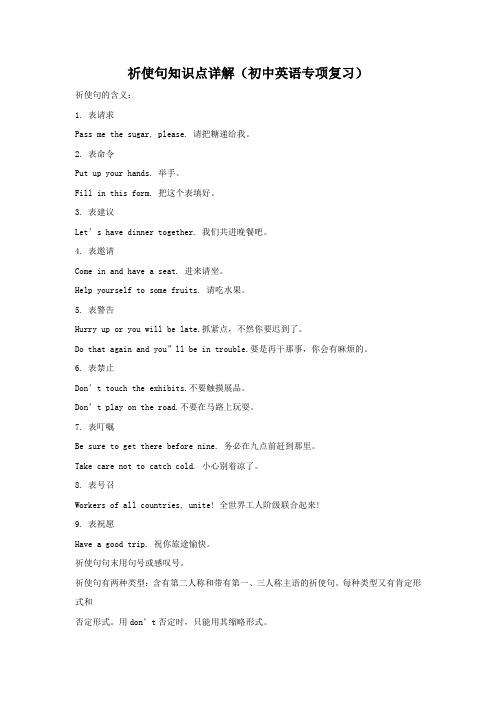
祈使句知识点详解(初中英语专项复习)祈使句的含义:1. 表请求Pass me the sugar, please. 请把糖递给我。
2. 表命令Put up your hands. 举手。
Fill in this form. 把这个表填好。
3. 表建议Let’s have dinner together. 我们共进晚餐吧。
4. 表邀请Come in and have a seat. 进来请坐。
Help yourself to some fruits. 请吃水果。
5. 表警告Hurry up or you will be late.抓紧点,不然你要迟到了。
Do that again and you”ll be in trouble.要是再干那事,你会有麻烦的。
6. 表禁止Don’t touch the exhibits.不要触摸展品。
Don’t play on the road.不要在马路上玩耍。
7. 表叮嘱Be sure to get there before nine. 务必在九点前赶到那里。
Take care not to catch cold. 小心别着凉了。
8. 表号召Workers of all countries, unite! 全世界工人阶级联合起来!9. 表祝愿Have a good trip. 祝你旅途愉快。
祈使句句末用句号或感叹号。
祈使句有两种类型:含有第二人称和带有第一、三人称主语的祈使句。
每种类型又有肯定形式和否定形式。
用don’t否定时,只能用其缩略形式。
例如:Welcome to Beijing Park.Walk about three blocks.Don’t mention it.无动词祈使句在请求、命令和口号中,常用无动词祈使句,它实际上是省略了动词,从而使语句更简洁或有力。
如:Just a minute, please! 请稍等!This way, please! 请这边走!Attention! 立正!Up the stairs! 上楼!To the playground, everyone of you! 到操场上去,你们每个人都得去!在一些指示牌上,常用“No +动名词/名词”构成简略式的否定祈使句。
Unit 7 Grammar 祈使句讲义与练习2021-2022学年牛津深圳版七年级英语下册

Unit 7 Grammar 祈使句祈使句是用来表示请求、命令、叮嘱、邀请、建议或劝告等的句子。
祈使句的主语一般是第二人称(you),但往往省略。
祈使句常常给人以“命令”他人的感觉,使人觉得唐突或莽撞。
祈使句一般不对比自己年长的人使用。
若使用,应加上please,或:使用相对委婉的语调。
例句:Open the window, please.请把窗户打开。
★祈使句的肯定形式祈使句可以以be动词,实义动词和Let开头,其肯定形式为be动词/实义动词/Let+其他部分。
例如:1. Be quiet,kids.孩子们,安静点。
2. Listen to me carefully, please.请仔细听我说话。
3. Let’s tell her the truth.让我们把实情告诉她吧。
★祈使句的否定形式祈使句的否定形式为Don’t/Do not + be动词/实义动词/let+其他部分。
注意;let的否定形式还可以为Let’s + not+动词原形.例如:1. Don’t / Do not be late again.不要再迟到了。
2. Don’t / Do not eat in the classroom.不要在教室里吃东西。
3. Don’t / Do not let her leave alone.不要让她独自离开。
4. Let’s not say anything about it.对于这件事,咱们什么也不要说了。
★除了以上语法规则之外,还应注意社会规则和礼仪。
1.紧急状况。
例如:A girl fell into the lake. Help! Help!一个女孩掉进湖里了。
救命啊!救命啊!2.欢呼喝彩。
例如:Come on,Peter! Make another goal!加油,彼得!再进一个球!3.提出请求。
例如:Dad, buy me the bike, please!爸爸,请给我买这个自行车吧!【扩展】a. 祈使句是一种具有较强交际功能的句型。
初中英语祈使句讲解及练习
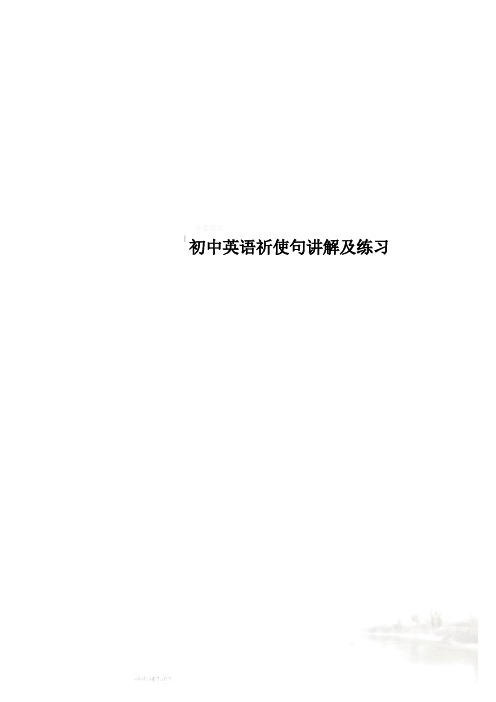
初中英语祈使句讲解及练习初中英语――祈使句祈使句指的是表示命令、请求、建议或劝告的句子。
其主语you常省略,谓语动词用原形,句末用感叹号或句号,读降调。
1. 肯定的祈使句(1)动词原形+其他Stand up, please. = Please stand up. 请起立。
(2)Be + n./adj.Be a good boy! 要做一个好孩子! Be careful! = Look out! = Take care! 小心/ 当心!(3)Let + 宾语+ 动词原形+ 其它成分Let me help you. 让我来帮你。
Let’s go to school together. 咱们一起上学去吧。
2. 否定的祈使句(1) Don't + 动词原形Don't stand up. 别站起来。
Don't be careless. 别粗心。
Don't let them play with fire. 别让他们玩火。
(2)Let型的否定式有两种:“Don't + let + 宾语+ 动词原形+ 其它成分”和“Let + 宾语如:--- Don’t go out, please. It’s raining heavily outside. 请不要出去。
外面雨下得很大。
---- Yes, I will. I have to meet my brother at the airport. 不行,我得去机场接我弟弟。
5. 祈使句的反意疑问句(1) 肯定祈使句的反意疑问句反问部分用will you 或won't you。
Please open the do or, will/ won’t you? 请把门打开,好吗?(2) 否定祈使句的反意疑问句反问部分只用will you。
Don't be late again, will you? 别再迟到了,行不行?(3) 以let's开头的祈使句反意疑问句反问部分用shall we。
(完整版)初中英语祈使句讲解及练习

(完整版)初中英语祈使句讲解及练习初中英语――祈使句祈使句指的是表示命令、请求、建议或劝告的句子。
其主语you 常省略,谓语动词用原形,句末用感叹号或句号,读降调。
1. 肯定的祈使句(1)动词原形 +其他Stand up, please. = Please stand up. 请起立。
(2)Be + n./adj.Be a good boy! 要做一个好孩子 ! Be careful! = Look out! = Take care! 小心 / 当心!(3)Let + 宾语 + 动词原形 + 其它成分Let me help you.让我来帮你。
Let ' s go to school together.咱们一起上学去吧。
2. 否定的祈使句(1) Don't + 动词原形Don't stand up. 别站起来。
Don't be careless. 别粗心。
Don't let them play with fire. 别让他们玩火。
(2) Let 型的否定式有两种:“Don't + let + 宾语 + 动词原形 + 其它成分”和“ Let + 宾语 + not +动词原形 + 其它成分” 。
Don't let him go. / Let him not go. 别让他走。
Let them not play with fire. 别让他们玩火。
(3) no 开头 ,用来表示禁止性的祈使句。
No smoking! 禁止吸烟 !No fishing! 禁止钓鱼 !3. 祈使句的强调形式,通常在肯定祈使句式前加上助动词 Do 。
例如: Do shut up! 快住口!4. 祈使句的回答祈使句的动作通常是表示将来发生的动作,所以回答祈使句时,一般用 will 或won ' t 。
在回答具有否定意义的祈使句时,要注意两点:1)形式一致(即Yes 与will 保持一致;No 与won ' t 保持一致)2)意思相反(即 Yes 是“不”的意思; No 是“是”的意思)。
初一人教版祈使句讲解及练习题

祈使句定义:用于表达意愿、命令、请求、劝告、警告、禁止等的句子。
Go and wash your hands. (去洗你的手。
——命令)Be quiet, please.(Please be quiet.)(请安静。
——请求)No parking. (禁止停车。
——禁止)No eating or drinking. (禁止吃喝。
——禁止)肯定句:1.Do型(即:动词原形(+宾语)+其它成分)。
如:Please have a seat here. 请这边坐。
2.Be型(即:Be + 表语(名词或形容词)+其它成分)。
如:Be a good boy! 要做一个好孩子!3.Let型(即:Let + 宾语+ 动词原形+ 其它成分)。
如:Let me help you. 让我来帮你。
否定句:1.Do型和Be型的否定式都是在句首加don't构成:如:Don't forget me! 不要忘记我!Don't be late for school! 上学不要迟到!是系表结构——也就是没有行为动词但是有形容词的那种——使用Don't be有行为动词的就不能这么用,只能用Don't2.Let型的否定式有两种:“Don't + let +宾语+ 动词原形+ 其它成分”和“Let + 宾语+ not + 动词原形+ 其它成分”。
如:Don't let him go. / Let him not go. 别让他走。
3.有些可用no开头,用来表示禁止性的祈使句。
如:No smoking! 禁止吸烟!No fishing! 禁止钓鱼!祈使句的后意疑问句:1. 肯定祈使句的反意疑问句反问部分用will you或won’t youPlease open the door, will/ won't you? 请把门打开,好吗?2. 否定祈使句的反意疑问句反问部分只用will you。
外研版七年级英语下册 初中祈使句练习(无答案)
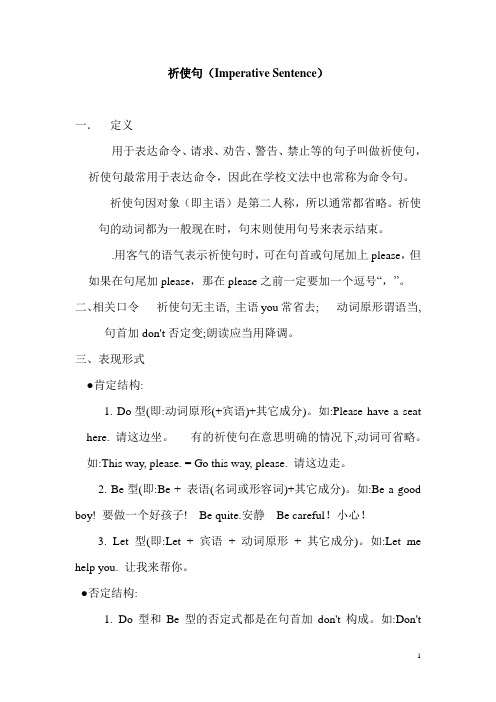
祈使句(Imperative Sentence)一.定义用于表达命令、请求、劝告、警告、禁止等的句子叫做祈使句,祈使句最常用于表达命令,因此在学校文法中也常称为命令句。
祈使句因对象(即主语)是第二人称,所以通常都省略。
祈使句的动词都为一般现在时,句末则使用句号来表示结束。
.用客气的语气表示祈使句时,可在句首或句尾加上please,但如果在句尾加please,那在please之前一定要加一个逗号“,”。
二、相关口令祈使句无主语, 主语you常省去; 动词原形谓语当,句首加don't否定变;朗读应当用降调。
三、表现形式●肯定结构:1. Do型(即:动词原形(+宾语)+其它成分)。
如:Please have a seat here. 请这边坐。
有的祈使句在意思明确的情况下,动词可省略。
如:This way, please. = Go this way, please. 请这边走。
2. Be型(即:Be + 表语(名词或形容词)+其它成分)。
如:Be a good boy! 要做一个好孩子! Be quite.安静Be careful!小心!3. Let型(即:Let + 宾语+ 动词原形+ 其它成分)。
如:Let me help you. 让我来帮你。
●否定结构:1. Do型和Be型的否定式都是在句首加don't构成。
如:Don'tforget me! 不要忘记我! Don't be late for school! 上学不要迟到!2. Let型的否定式有两种:“Don't + let + 宾语+ 动词原形+ 其它成分”和“Let + 宾语+ not + 动词原形+ 其它成分”。
如:Don't let him go. / Let him not go. 别让他走。
3. 有些可用no开头,用来表示禁止性的祈使句。
如:No smoking!禁止吸烟!No fishing! 禁止钓鱼!四.反意疑问句,祈使句后可以加一个简短问句,使语气变得客气一些.如:Have a rest,will you .Stand up,will (won't) you .注意:Let''s go,shall we?Let us go,will you?祈使句练习一、将以下祈使句改为否定式:1. Come here early.2. Ask him.3. Please wait for her.4. Read the book carefully.5. Sit under the tree, please.6. Let’s go there together.二、选择最佳答案填空:( )1. If you are tired, ______ a rest.A. haveB. havingC. to haveD. had( ) 2. He is not honest. ______ believe him.A. NotB. Don’tC. To notD. Not to( )3. _____ in the street. It’s dangerous.A. Not playB. Not to playC. Don’t playD. Don’t to play ( )4. Please ______ me some money, will you?A. lendB. lendingC. to lendD. be lend( )5. The film is about to begin. Please ______ seated.A. beB. areC. isD. being( )6. _____ the boxes. You may use them later.A. KeepB. KeepingC. To keepD. Kept( )7. _____ up early tomorrow, or you can’t catch the train.A. GettingB. GetC. To getD. Got( )8.Her doctor said: “________ work so hard”A StopB Don’tC Can’tD No( )9. Sindy, ________ to be here at 8 o’clockA is sureB do sure thatC will be sureD be sure( )10. ________him the secret, will you?A. Don’t tellB. Not to tellC. Not tellingD. No telling( )11. ________ in bed. It’s bad for your eyes.A. Not to readB. Don’t readC. Don’t to readD. Not read( 12. ________ Your child. We’ll look after him.A. Not to worry about B .Don’t worry aboutC . Not worry forD .Don’t worry with( )13.They are very tired. Why ________ have a rest?A. not they B .do not they C .don’t they D .not to( )14. --You look rather tired. ________ stopping to have a rest?-- All right.A .Why not B. How about C. Why not to D.why don’t( ) 15. ______ tell a lie.A Hardly B. Not C. No D .Never、( )16.Please ________ look outside. Look at the blackboard.A. notB. don’t C .aren’t D. can’t( )17 .Her doctor said: “________ work so hard”A .StopB .Don’t C. Can’t D. No( )18. 1. The TV is too loud. Please________.A. turn it downB. to turn it downC. turn down itD. to turn down it( )19.________ when you cross the road.A. Do careB. CareC. Be carefulD. To be careful ( )20. ________him the secret, will you?A. Don’t tell B .Not to tell C. Not telling D. No telling ( )21. If you want to stay, let me know, ______?A. will youB. shall weC. do youD. do we( )22. Never come late again, ______?A. will youB. wo n’tC. do youD. does he ( )23. John, read the text for us,________?A does heB will heC do youD will you ( )24. Let’s do it at once, ________ ?A shall weB will youC do weD do you ( )25. Let us do it at once, ________ ?A shall weB will youC do weD doyou三.用括号内所给动词的适当形式填空。
专题18 祈使句60道(知识详解名校期末真题) (人教版)
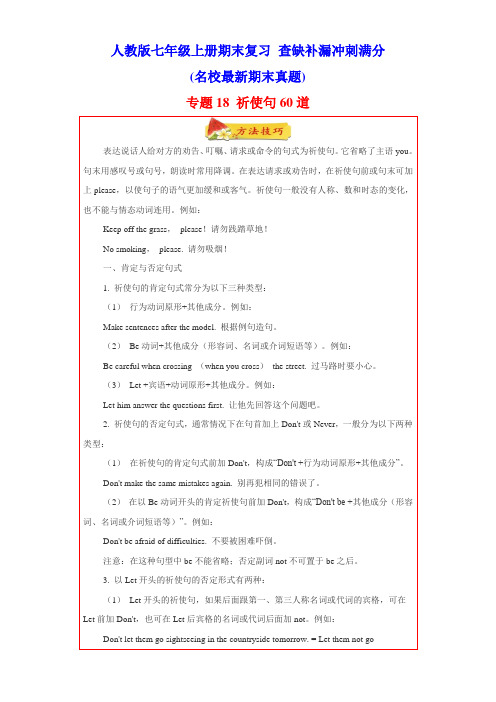
人教版七年级上册期末复习查缺补漏冲刺满分(名校最新期末真题)专题18 祈使句60道表达说话人给对方的劝告、叮嘱、请求或命令的句式为祈使句。
它省略了主语you。
句末用感叹号或句号,朗读时常用降调。
在表达请求或劝告时,在祈使句前或句末可加上please,以使句子的语气更加缓和或客气。
祈使句一般没有人称、数和时态的变化,也不能与情态动词连用。
例如:Keep off the grass,please!请勿践踏草地!No smoking,please. 请勿吸烟!一、肯定与否定句式1. 祈使句的肯定句式常分为以下三种类型:(1)行为动词原形+其他成分。
例如:Make sentences after the model. 根据例句造句。
(2)Be动词+其他成分(形容词、名词或介词短语等)。
例如:Be careful when crossing (when you cross)the street. 过马路时要小心。
(3)Let +宾语+动词原形+其他成分。
例如:Let him answer the questions first. 让他先回答这个问题吧。
2. 祈使句的否定句式,通常情况下在句首加上Don't或Never,一般分为以下两种类型:(1)在祈使句的肯定句式前加Don't,构成“Don't +行为动词原形+其他成分”。
Don't make the same mistakes again. 别再犯相同的错误了。
(2)在以Be动词开头的肯定祈使句前加Don't,构成“Don't be +其他成分(形容词、名词或介词短语等)”。
例如:Don't be afraid of difficulties. 不要被困难吓倒。
注意:在这种句型中be不能省略;否定副词not不可置于be之后。
3. 以Let开头的祈使句的否定形式有两种:(1)Let开头的祈使句,如果后面跟第一、第三人称名词或代词的宾格,可在Let前加Don't,也可在Let后宾格的名词或代词后面加not。
中考初中语法祈使句情态动词专题讲解与练习

中考初中语法祈使句情态动词专题讲解与练习情态动词一.情态动词can_________________ can’t_____________________May_________________ may not______________________Must______________ mustn’t_______________________二、情态动词的特点1. 情态动词无人称和数的变化,2. 情态动词后面跟的动词需用原形,否定式构成是在情态动词后面加 "not"。
3. 个别情态动词有过去式, 过去式用来表达更客气, 委婉的语气, 时态性不强, 可用于过去,现在。
三、情态动词的用法1. can/could;can’t/couldn’t (否定)1) 表示能力, 意为“能、会”, 例如:I can speak a little English. -- Can you ride a bike?I can’t swim. -- Yes, I can. / No, I can’t.2) 表示请求或允许,多用于口语中,意为“可以、能”等You can go home now. 现在你可以回家了 -- Can I borrow your bike?You can’t stop your car here. -- Yes, you can. / No, you can’t.3) 用于否定句、疑问句中,表示猜测、怀疑或不肯定.Lucy can’t be at home now, she went to the park just now.Where can it be? I can’t find my football.【注意:】1). could 是can的过去式, 有两种用法, 一种表示过去式;一种用来表达更加客气, 委婉的语气, 时态性不强, 可用于过去,现在。
2). be able to 意为“有能力,能够做...”, 相当于can/could, 但它有人称,数和时态的变化。
祈使句知识点详解(初中英语专项复习)22
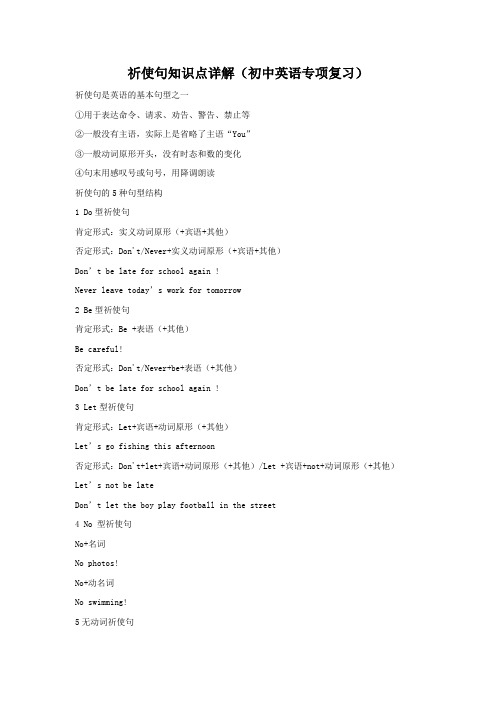
祈使句知识点详解(初中英语专项复习)祈使句是英语的基本句型之一①用于表达命令、请求、劝告、警告、禁止等②一般没有主语,实际上是省略了主语“You”③一般动词原形开头,没有时态和数的变化④句末用感叹号或句号,用降调朗读祈使句的5种句型结构1 Do型祈使句肯定形式:实义动词原形(+宾语+其他)否定形式:Don't/Never+实义动词原形(+宾语+其他)Don’t be late for school again !Never leave today’s work for tomorrow2 Be型祈使句肯定形式:Be +表语(+其他)Be careful!否定形式:Don't/Never+be+表语(+其他)Don’t be late for school again !3 Let型祈使句肯定形式:Let+宾语+动词原形(+其他)Let’s go fishing this afternoon否定形式:Don't+let+宾语+动词原形(+其他)/Let +宾语+not+动词原形(+其他)Let’s not be lateDon’t let the boy play football in the street4 No 型祈使句No+名词No photos!No+动名词No swimming!5无动词祈使句主要是以形容词、副词、名词构成的祈使句Careful !Quickly!Eyes front !祈使句的反义疑问句1若陈述部分为祈使句,疑问部分通常用will you /won’t you/would you 等若陈述部分为否定式,则疑问部分为will you2当祈使句为Let us...时,表示建议疑问部分总是用shall we3当祈使句为Let us...时(1)若表示请求,疑问部分用will you(2)若表示建议,疑问部分用shall we4当祈使句带有主语时,有时祈使句带有自己的主语,此时不要将其误以为是陈述句,可以通过上下文判断其句意补充—句型转换祈使句与陈述句的句型转换祈使句=You must...(陈述句)“祈使句+and/or+简单句”可转换为if引导的条件状语从句的复合句Use your head and you’ll find a way=If you use your hand,you’ll find a wayHurry up,or we’ll be late=If we don’t hurry up,we’ll be late祈使句用法口诀祈使句,无主语,动词开头就可以表示请求或命令,加上please表客气要想变成否定句,Don't开头别忘记。
中考英语祈使句讲解及练习
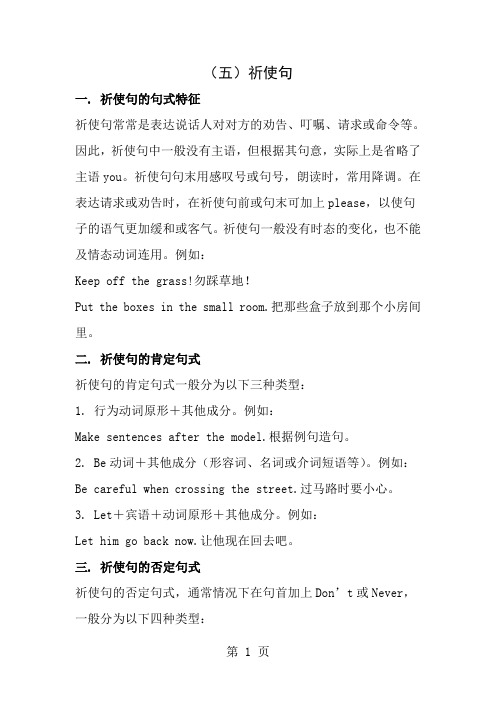
(五)祈使句一. 祈使句的句式特征祈使句常常是表达说话人对对方的劝告、叮嘱、请求或命令等。
因此,祈使句中一般没有主语,但根据其句意,实际上是省略了主语you。
祈使句句末用感叹号或句号,朗读时,常用降调。
在表达请求或劝告时,在祈使句前或句末可加上please,以使句子的语气更加缓和或客气。
祈使句一般没有时态的变化,也不能及情态动词连用。
例如:Keep off the grass!勿踩草地!Put the boxes in the small room.把那些盒子放到那个小房间里。
二. 祈使句的肯定句式祈使句的肯定句式一般分为以下三种类型:1. 行为动词原形+其他成分。
例如:Make sentences after the model.根据例句造句。
2. Be动词+其他成分(形容词、名词或介词短语等)。
例如:Be careful when crossing the street.过马路时要小心。
3. Let+宾语+动词原形+其他成分。
例如:Let him go back now.让他现在回去吧。
三. 祈使句的否定句式祈使句的否定句式,通常情况下在句首加上Don’t或Never,一般分为以下四种类型:1. 在祈使句的肯定句式前加Don’t,构成“Don’t+行为动词原形+其他成分”。
例如:Don’t say that again!别再那样说了!2. 在Be动词引起的肯定祈使句前加Don’t,构成“Don’t be +其他成分(形容词、名词或介词短语等)”。
例如:Don’t be careless.不要粗心。
注意:在这种句型中be不能省略;否定副词not不可置于be之后。
3. Let引起的祈使句的否定形式有两种:(1)Let开头的祈使句,如果后面跟第一、第三人称名词或代词的宾格,可在Let前加Don’t,也可在Let后宾格的名词或代词后面加not。
(2)如果以Let’s开头的祈使句,必须在Let’s后加not。
祈使句讲解及练习

英语祈使句精讲及练习()一、祈使句(Imperative Sentence)定义:用于表达命令、请求、劝告、警告、禁止等的句子叫做祈使句.祈使句因对象(即主语)是第二人称,所以通常都省略。
祈使句的动词都为一般现在时,句末则使用句号来表示结束。
例:Go and wash your hands.(去洗你的手。
——命令)Be quiet, please.(Please be quiet.)(请安静。
——请求)Be kind to our sister.(对姊妹要和善。
——劝告)Watch your steps.(走路小心。
——警告)Look out!Danger!(小心!危险!——强烈警告,已如感叹句)Keep off the grass.(勿践草坪。
——禁止)No parking.(禁止停车。
——禁止)二、相关口诀祈使句无主语, 主语you常省去;动词原形谓语当, 句首加don't否定变;朗读应当用降调, 句末常标感叹号。
三、表现形式●肯定结构:1. Do型(即:动词原形(+宾语)+其它成分)。
如:Please have a seat here. 请这边坐。
有的祈使句在意思明确的情况下,动词可省略。
如:This way, please. = Go this way, please. 请这边走。
2. Be型(即:Be + 表语(名词或形容词)+其它成分)。
如:Be a good boy! 要做一个好孩子!3. Let型(即:Let + 宾语 + 动词原形 + 其它成分)。
如:Let me help you. 让我来帮你。
●否定结构:1. Do型和Be型的否定式都是在句首加don\'t构成。
如:Don\'t forget me! 不要忘记我!Don\'t be late for school! 上学不要迟到!2. Let型的否定式有两种:“Don\'t + let + 宾语 + 动词原形 + 其它成分”和“Let + 宾语 + not + 动词原形 + 其它成分”。
新初中英语语法知识—祈使句的技巧及练习题附答案解析
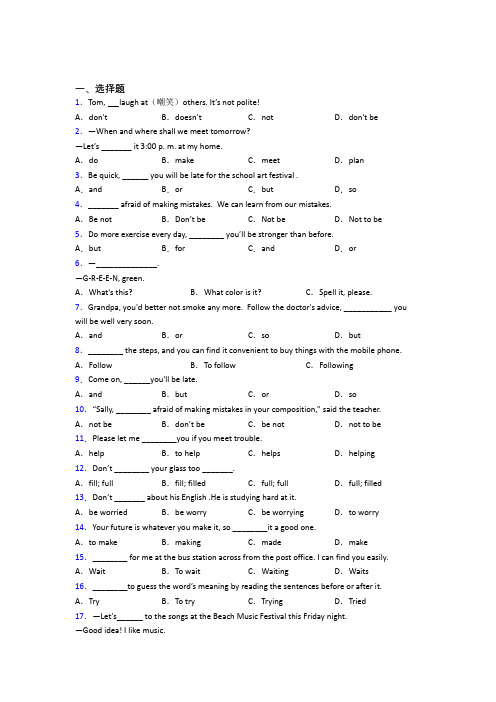
一、选择题1.Tom, laugh at(嘲笑)others. It’s not polite!A.don't B.doesn’t C.not D.don't be 2.—When and where shall we meet tomorrow?—Let’s _______ it 3:00 p. m. at my home.A.do B.make C.meet D.plan3.Be quick, ______ you will be late for the school art festival .A.and B.or C.but D.so4._______ afraid of making mistakes. We can learn from our mistakes.A.Be not B.Don’t be C.Not be D.Not to be 5.Do more exercise every day, ________ you’ll be stronger than before.A.but B.for C.and D.or6.—______________.—G-R-E-E-N, green.A.What's this? B.What color is it? C.Spell it, please. 7.Grandpa, you'd better not smoke any more. Follow the doctor's advice, ___________ you will be well very soon.A.and B.or C.so D.but8.________ the steps, and you can find it convenient to buy things with the mobile phone. A.Follow B.To follow C.Following9.Come on, ______you'll be late.A.and B.but C.or D.so 10.“Sally, ________ afraid of making mistakes in your composition,” said the teacher. A.not be B.don’t be C.be not D.not to be 11.Please let me ________you if you meet trouble.A.help B.to help C.helps D.helping 12.Don’t ________ your glass too _______.A.fill; full B.fill; filled C.full; full D.full; filled 13.Don’t _______ about his English .He is studying hard at it.A.be worried B.be worry C.be worrying D.to worry 14.Your future is whatever you make it, so ________it a good one.A.to make B.making C.made D.make15.________ for me at the bus station across from the post office. I can find you easily. A.Wait B.To wait C.Waiting D.Waits16.________to guess the word’s meaning by reading the sentences before or after it. A.Try B.To try C.Trying D.Tried 17.—Let’s______ to the songs at the Beach Music Festival this Friday night.—Good idea! I like music.A.listening B.listen C.listens D.to listen18.me a chance and I’ll bring you a surprise.A.Give B.Giving C.Gives D.To give 19.—Nick, __________ the door when you leave the classroom.—All right. I will.A.to close B.closing C.closed D.close20.________ any more. It’s no use. We will not buy you any chocolate.A.You don’t cry B.If you cry C.Don’t cry D.Stop crying 21.Study hard, ________you ________pass the exam.A.and, won’t B.or, will C.or, / D.and, will 22.Tom, please. I am afraid it will take you one more hour your homework.A.be quick; finish B.is quick; finishing C.be quick; to finish D.be quickly; to finish 23.Practice more, _______ you’ll learn English better.A.or B.so C.and D.but24.Alice, it's time for school. Let me _______, or I will be late for class.A.go B.come C.to go D.to come 25.—Let’s __________ volleyball.— That __________ good.A.playing;sounds B.play;soundsC.play;sound D.plays;sound【参考答案】***试卷处理标记,请不要删除一、选择题1.A解析:A【解析】【详解】句意:汤姆,别嘲笑别人。
初中英语祈使句讲解及练习(附答案)

初中英语祈使句讲解及练习(附答案)1.Don't make any noise。
Your mother is XXX.XXX.3.XXX.4.In affirmative imperative sentences。
the verb is in its base form and the subject "you" is often omitted。
Use an n mark or a d at the end of the sentence.5.Examples of affirmative imperative sentences include using the verb in its base form with other words。
using "be" with a noun or adjective。
and using "let" with an object and the verb in its base form.6.Negative imperative sentences use "don't" before the verb in its base form or use "let" with "not" before the verb in its base form。
Another n is to start the sentence with "no" to XXX.7.XXX imperative sentence。
add the auxiliary verb "do" before the main verb.8.When answering an imperative sentence。
初中英语中考语法复习 祈使句的知识点归纳和练习题(有答案)
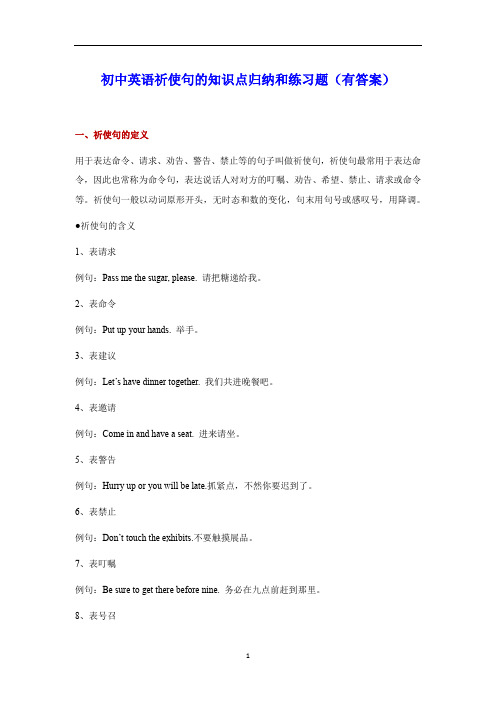
初中英语祈使句的知识点归纳和练习题(有答案)一、祈使句的定义用于表达命令、请求、劝告、警告、禁止等的句子叫做祈使句,祈使句最常用于表达命令,因此也常称为命令句,表达说话人对对方的叮嘱、劝告、希望、禁止、请求或命令等。
祈使句一般以动词原形开头,无时态和数的变化,句末用句号或感叹号,用降调。
●祈使句的含义1、表请求例句:Pass me the sugar, please. 请把糖递给我。
2、表命令例句:Put up your hands. 举手。
3、表建议例句:Let’s have dinner together. 我们共进晚餐吧。
4、表邀请例句:Come in and have a seat. 进来请坐。
5、表警告例句:Hurry up or you will be late.抓紧点,不然你要迟到了。
6、表禁止例句:Don’t touch the exhibits.不要触摸展品。
7、表叮嘱例句:Be sure to get there before nine. 务必在九点前赶到那里。
8、表号召例句:Workers of all countries, unite! 全世界工人阶级联合起来!9、表祝愿例句:Have a good trip. 祝你旅途愉快。
●祈使句的特点:1、谓语大都是表示行为动作的动词或动词性词语,表示的动作是未然的。
2、主语一般是第二人称代词“你、你们”,往往省去。
也有时用第一人称“咱们”作主语。
国内外许多语法家认为不仅有第二人称的祈使句,还有第一、三人称的祈使句。
从语义学方面进行分析研究,祈使句的主语实质上都是第二人称。
●祈使句的语调特点:1.语音强度一般比陈述句重,书面上用感叹号表示。
2.句末用降调,较长句子的后半部分几个音节速度加快。
二、祈使句的分类祈使句表请求、命令、叮嘱、邀请、劝告等。
祈使句分为第二人称祈使句及第—、三人称祈使句两大类。
1、第二人称祈使句通常用来向听话者发出命令,提出要求或建议。
初中英语语法祈使句知识点讲解及专项练习
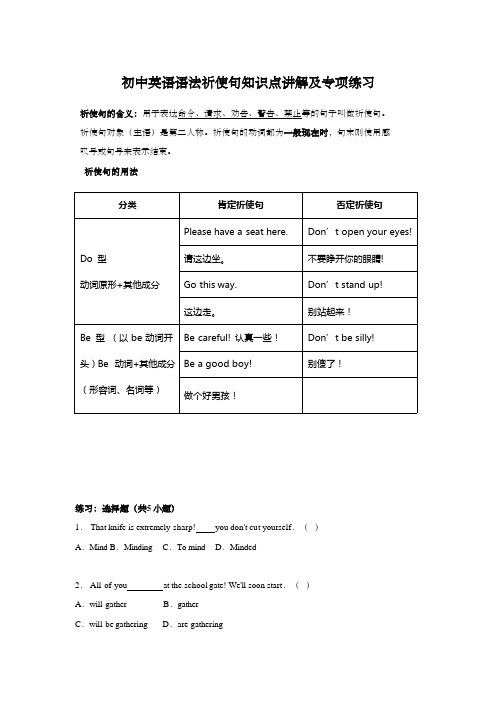
初中英语语法祈使句知识点讲解及专项练习祈使句的含义:用于表达命令、请求、劝告、警告、禁止等的句子叫做祈使句。
祈使句对象(主语)是第二人称。
祈使句的动词都为一般现在时,句末则使用感叹号或句号来表示结束。
祈使句的用法分类肯定祈使句否定祈使句Please have a seat here. Don’t open your eyes! Do 型请这边坐。
不要睁开你的眼睛!动词原形+其他成分Go this way. Don’t stand up!这边走。
别站起来!Be 型(以 be 动词开Be careful! 认真一些!Don’t be silly!头)Be 动词+其他成分Be a good boy! 别傻了!(形容词、名词等)做个好男孩!练习:选择题(共5小题)1. That knife is extremely sharp! you don't cut yourself.()A.Mind B.Minding C.To mind D.Minded2. All of you at the school gate! We'll soon start.()A.will gather B.gatherC.will be gathering D.are gathering3.smiling and one day life will get tired of upsetting you.()A.To keep B.Keeping C.Keep D.Having kept4. Every time at the door before you enter my room,please.()A.knocked B.knocking C.knock D.to knock5. Cindy,to be here at 8 o’clock.()A.is sure B.is sure that C.will be sure D.be sure解析:选择题(共5小题)1.【解答】答案:A空前为一个感叹句,故you don't cut yourself 应该为一个完整句子,祈使句表警告,故选A.2.【解答】答案:B 本题考查祈使句结构和句意结构理解.本题容易误当作时态题,如果前面是一个陈述句,那么前后句子之间没有逻辑关系;从句中的感叹号可以看出是表达命令的;all of you 表示说话的对象.故选B.3.【解答】答案:C 题干中a nd 是并列连词,后面是一个陈述句,前面也应该是一个句子.选项中只有动词原形能构成祈使句,故选C.4.【解答】答案:C.考察句式结构.本句中为b efore 引导的时间状语从句,可推断前面应该是主句部分的谓语,只有A项为祈使句的谓语动词,符合条件.5.【解答】答案:D.这里的C indy 不是主语,而是称呼,后面是祈使句,用b e 动词原形,排除A,B 和C项.如若选B,句子表达应该是“Cindy is sure that he will be here at 8 o’clock”;所以选D.。
祈使句详解及练习

祈使句详解及练习英语祈使句(Imperative Sentence)一、定义用于表达命令、请求、劝告、警告、禁止等的句子叫做祈使句,祈使句最常用于表达命令,因此在学校代法中也常称为命令句。
祈使句因对象(即主语)是第二人称,所以通常都省略。
祈使句的动词都为一般现在时,句末则使用句号来表示结束。
例:Go and wash your hands.(去洗你的手。
——命令)Be quiet, please.(Please be quiet.)(请安静。
——请求)Be kind to our sister.(对姊妹要和善。
——劝告)Watch your steps.(走路小心。
——警告)Look out!Danger!(小心!危险!——强烈警告,已如感叹句)Keep off the grass.(勿践草坪。
——禁止)No parking.(禁止停车。
——禁止)祈使句也常把主语“You”表达出来,使对方听起来觉得柔和些,例如:You go and tell him, Chris. (克立斯你去告诉他。
)二、表现形式●肯定结构:1. Do型(即:动词原形(+宾语)+其它成分)。
如:Please have a seat here. 请这边坐。
有的祈使句在意思明确的情况下,动词可省略。
如:This way,please. = Go this way, please. 请这边走。
2. Be型(即:Be + 表语(名词或形容词)+其它成分)。
如:Be a good boy! 要做一个好孩子!3. Let型(即:Let + 宾语+ 动词原形+ 其它成分)。
如:Let me help you. 让我来帮你。
●否定结构:1. Do型和Be型的否定式都是在句首加don't构成。
如:Don't forget me! 不要忘记我!Don't be late for school! 上学不要迟到!2. Let型的否定式有两种:“Don't + let + 宾语+ 动词原形+ 其它成分”和“Let + 宾语+ not + 动词原形+ 其它成分”。
- 1、下载文档前请自行甄别文档内容的完整性,平台不提供额外的编辑、内容补充、找答案等附加服务。
- 2、"仅部分预览"的文档,不可在线预览部分如存在完整性等问题,可反馈申请退款(可完整预览的文档不适用该条件!)。
- 3、如文档侵犯您的权益,请联系客服反馈,我们会尽快为您处理(人工客服工作时间:9:00-18:30)。
初中英语――祈使句祈使句指的是表示命令、请求、建议或劝告的句子。
其主语you常省略,谓语动词用原形,句末用感叹号或句号,读降调。
1. 肯定的祈使句(1)动词原形+其他Stand up, please. = Please stand up. 请起立。
(2)Be + n./adj.Be a good boy! 要做一个好孩子! Be careful! = Look out! = Take care! 小心/ 当心!(3)Let + 宾语+ 动词原形+ 其它成分Let me help you. 让我来帮你。
Let’s go to school together. 咱们一起上学去吧。
2. 否定的祈使句(1) Don't + 动词原形Don't stand up. 别站起来。
Don't be careless. 别粗心。
Don't let them play with fire. 别让他们玩火。
(2)Let型的否定式有两种:“Don't + let + 宾语+ 动词原形+ 其它成分”和“Let + 宾语+ not + 动词原形+ 其它成分”。
Don't let him go. / Let him not go. 别让他走。
Let them not play with fire. 别让他们玩火。
(3)no开头,用来表示禁止性的祈使句。
No smoking! 禁止吸烟!No fishing! 禁止钓鱼!3. 祈使句的强调形式,通常在肯定祈使句式前加上助动词Do。
例如:Do shut up! 快住口!4. 祈使句的回答祈使句的动作通常是表示将来发生的动作,所以回答祈使句时,一般用will或won’t。
在回答具有否定意义的祈使句时,要注意两点:1)形式一致(即Yes与will保持一致;No与won’t保持一致)2) 意思相反(即Yes是“不”的意思;No是“是”的意思)。
在回答时,要注意分析上下文语境中所提供的条件。
如:--- Don’t go out, please. It’s raining heavily outside. 请不要出去。
外面雨下得很大。
---- Yes, I will. I have to meet my brother at the airport. 不行,我得去机场接我弟弟。
5. 祈使句的反意疑问句(1) 肯定祈使句的反意疑问句反问部分用will you 或won't you。
Please open the door, will/ won’t you? 请把门打开,好吗?(2) 否定祈使句的反意疑问句反问部分只用will you。
Don't be late again, will you? 别再迟到了,行不行?(3) 以let's开头的祈使句反意疑问句反问部分用shall we。
Let's turn on the TV, shall we? 我们把电视打开,好吗?<特别注意> 只有以let's开头的祈使句的反意疑问句的反问部分才用shall we,而let us 开头的祈使句的反意疑问句的反问部分应为will you或won't you.如:Let us stay here, will/ won't you? 请(你)让我们留在这好吗?一. 用括号内所给动词的适当形式填空。
1.It’s an important meeting. _________________ (not, be )late.2.________________ (not,make) any nise! Your mother is sleeping.3.________________ (not, speak) with your mouth full of food and _________ (be) polite.4. ________________ ( not, talk) and ____________ (read) aloud.5._______________ (not,leave) your homework for tomorrow, Larry.6.________________ (look) out! A car is coming.7._______________ (give) us ten years and just see what our country will be like.8.________________ (not, let) the baby cry.9.Wear more clothes or you ____________ (catch) a cold.10. Let’s _______________ (not, say) anything about it.二、单项选择1. The TV is too loud. Please________.A. turn it downB. to turn it downC. turn down itD. to turn down it2. _______ late again, Bill!A. Don't to beB. Don't beC. Not beD. Be not3. _______ cross the road until the traffic lights turn green.A. NotB. Won'tC. Doesn'tD. Don't4. Please help me carry it, ______?A. will IB. will youC. shall ID. shall we5. Don't make so much noise, ______?A. will youB. won't youC. shall weD. do you6. Do you know the girl ______under the tree?A. standB. to standC. standingD. stood7. Kate, _______ your homework here tomorrow.A. bringB. bringsC. to bringD. bringing8. ________ me the truth, or I'll be angry.A. TellingB. To tellC. ToldD. Tell9. I've kept the dog _______Maomao for a long time.A. NameB. namedC. namingD. to name10. Don't you know that _______ is good for our health?A. swimB. swimmingC. swamD. swims11 .Her doctor said: “________ work so hard”A StopB Don’tC Can’tD No12. Sindy, ________ to be here at 8 o’clockA is sureB is sure thatC will be sureD be sure13.________ when you cross the road.A Do careB CareC Do be carefulD To be careful14. ________him the secret, will you?A Don’t tellB Not to tellC Not tellingD No telling15. ________ in bed. It’s bad for your eyes.A Not to readB Don’t readC Don’t to readD Not read16. ________ Your child. We’ll look after him.A Not to worry aboutB Don’t worry aboutC Not worry forD Don’t worry with17.They are very tired. Why ________ have a rest?A not theyB do not theyC don’t theyD not to18 --You look rather tired. ________ stopping to have a rest?-- All right.A Why notB How aboutC Why not toD why don’t19 ______ tell a lie.A HardlyB NotC NoD Never20.Please ________ look outside. Look at the blackboard.A notB don’tC aren’tD can’t三、句型转换1. Will you please read it again more slowly? (改为祈使句)_______ ________ again more slowly, please.2. If you don't listen to me, I'll go. (改为同义句)________ ________me, or I’ll go.3. Let's watch the sports games. (改为反意疑问句)Let's watch the sports games, _______ _____?4. The teachers often tell the students not to be careless. (改为祈使句)_______ _______careless, please.5. Please sit next to Nancy. (改为否定句)_______ _______ next to Nancy.6. Don't forget to turn off the lights, please. (改为反意疑问句)Don't forget to turn off the lights, _______ _______?7. If you move, you'll die. (改为同义句)_______ ______, or you'll die.8. Come to my house tomorrow. (改为反意疑问句)Come to my house tomorrow, _______ _______?9. 这是一个坏了的被子。
